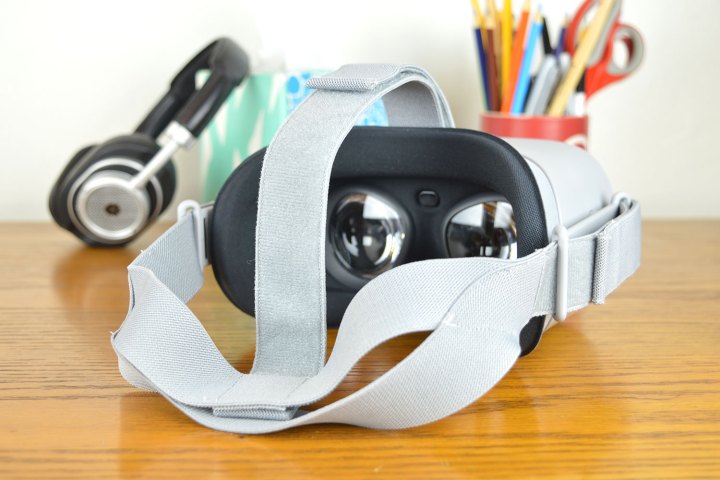
Where once Oculus was the defacto front-runner in the virtual reality scene, today there are a number of competitors out there all producing top-tier virtual reality hardware for PC, console, and mobile.
Lenovo hasn’t been in the market long, but its Mirage Solo with Daydream headset is already making waves. As stand-alone VR headsets, how does these two compare?
Design

Looking very much like an evolved version of its bigger brother, the Oculus Go is a sleek and sophisticated looking headset. It has an off-white color scheme which helps it stand out without looking garish or cheap, and its materials give it a premium feel. The headstrap is velcro-attached fabric, which makes it easy to put on and take off, though not quite as easy to adjust as headsets with the turn dial tightening system.
The dial is something the Lenovo Mirage Solo does sport, which makes tweaking its headstrap length a little easier. However the headset itself is 0.4 pounds heavier than the Go and you can tell. It’s comfortable, but its tight fit does make it a rather hot and potentially sweaty experience. With no ability to remove the face padding, the best you can do is wipe it down frequently.
In terms of looks and feel, the Mirage Solo has a chunkier design with a hard, white plastic shell. Its heft and weight make it much more of a stationary device than something we’d want to take out and about with us, despite its wire-free design. It doesn’t have such a quality look as the Go, but its front-facing dual cameras do make it stand out. You might feel a little silly wearing it, but there isn’t a VR headset available right now that doesn’t have that as part and parcel of the experience.
Both headsets offer 3.5mm connections for headphones or earbuds, but the Go also has speakers built into the headstrap should you want a better ear for the environment around you while exploring virtual worlds.
Performance

Both the Mirage Solo and Go are very much mid-tier virtual reality headsets and don’t exhibit the kinds of features or specifications we’ve come to expect from high-end headsets like the Vive Pro. That doesn’t mean they have weak hardware though.
The Oculus Go features a 5.5-inch LCD screen with a resolution of 2,560 x 1,440 and a standard refresh rate of 60Hz, though some apps can force it to run at 72Hz instead by sacrificing battery life. In comparison, the Mirage Solo has an LCD display with the same resolution, though its default refresh rate is 75Hz.
While the displays are comparably decent, the field of view of the Mirage is a little wider at 110 degrees — the same as the Oculus Rift and HTC Vive — while the Oculus Go is more comparable to the Samsung Gear VR at 101 degrees.
Both headsets are stand-alone, meaning they don’t require a phone or PC connection to run. All the hardware is internal. With the Oculus Go, you have a Qualcomm Snapdragon 821 processor and 32GB of storage. The Mirage Solo’s hardware is newer and heftier, with a Snapdragon 835 processor and 64GB of storage space. That makes the Lenovo headset much more powerful and could be why it has the same 2.5-hour rated battery life as the Go, despite featuring a 4,000 mAh battery, compared to the Go’s 2,600 mAh.
It’s also a major factor in the Oculus Go being around half the price of the Mirage Solo. The former will set you back just $200, while you’ll find the Lenovo headset more commonly sold at $400 .
Tracking and controllers

Both headsets are stand-alone and require no external trackers, but they do have different systems for mapping where you are in the digital space. Where the Oculus Go offers three degrees of movement using its onboard accelerator, gyroscope, and magnetometer, the Lenovo Daydream headset combines that with dual inside-out tracking cameras to provide positional tracking too. That gives wearers six degrees of freedom, letting them move forward, backwards, upwards and down, as well as tilting and turning. That makes for much more immersive and interactive experiences in your favorite virtual reality apps.
Neither headset’s controllers offer such freedom. Though they can track tilts and orientation, you can’t reach out and grab things in their iterations of virtual reality. Their remotes are comparable in most other ways too, with various button inputs offering basic in-app interaction.
Content

The Lenovo Mirage Solo with Daydream offers a decent spread of applications for new buyers, with around 250 in total. We particularly enjoyed its suite of educational experiences and video content. The 40-odd WorldSense-supporting applications that take full advantage of its six degrees of movement are the most immersive you’re likely to get in a standalone VR headset.
The Oculus Go however, enjoys a much larger library of content. While none will let you walk around in the real world to navigate them, with more than 1,000 to choose from, the content library for the Go is much broader, even if it’s not as deep.
Two tiers of headset

The comparison of the Oculus Go and Lenovo Mirage Solo with Daydream is a little like the original launch of the Rift and Vive. Where both offer decent virtual reality experiences, the cheaper Oculus hardware doesn’t quite measure up to the more complete virtual reality experience offered by its counterpart. Between the Lenovo Mirage Solo and the Oculus Go, Lenovo’s is the higher-quality experience. If you want more from your VR than a standing or seated experience and don’t mind forking out $400 for it, the Lenovo Mirage Solo headset offers a more interactive, better-looking VR space to explore.
That said, we have to give the slight recommendation to the Oculus Go. It’s a nicer fit, its aesthetics are more pleasing, and — most importantly — it has a much more expansive library of content to explore. At just $200 , it’s the better choice for those who are exploring virtual reality for the first time.
Editors' Recommendations
- Surface Laptop Go 3 vs. Surface Pro 7+: is it an upgrade?
- With Lenovo’s Legion Go, do we finally have a Steam Deck killer?
- Microsoft Surface Pro 9 vs. Lenovo IdeaPad Duet 5i: which 2-in-1 is best?
- Lenovo ThinkPad X12 Detachable vs. Microsoft Surface Pro 8
- Surface Go 3 vs. iPad (2021): Battle of the budget tablets




